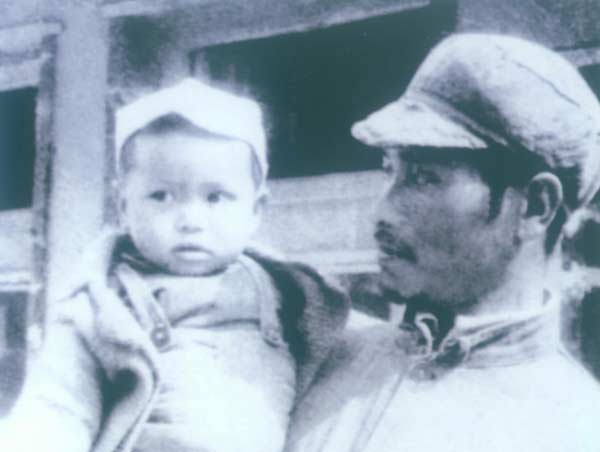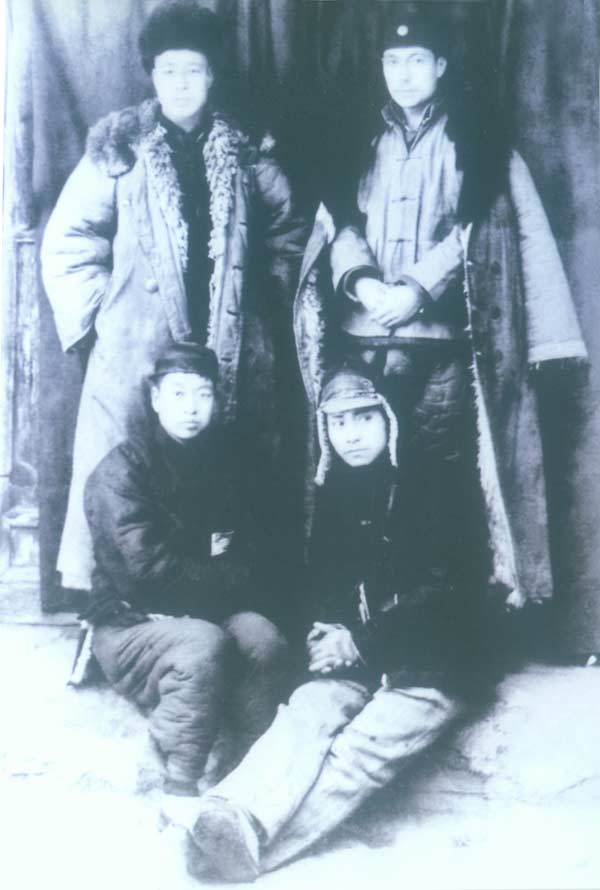 |
|
Hong Shui (aka Nguyen Son) with his first son Chen Hanfeng in 1945, the year he left for his native Vietnam at the invitation of President Ho Chi Minh. [Photo provided to China Daily] |
Editor's Note: Whampoa, China's first modern military academy, founded 90 years ago, was a beacon of liberation and the training ground of many of China's best-known revolutionaries during the following three decades. World War I, in which 140,000 Chinese served on the European Western Front, began 100 years ago, and next year will be the 70th anniversary of the end of World War II, the most devastating global conflict in history, marked by the Holocaust and prefigured in China by the start of the War of Resistance against Japanese Aggression in 1937 and the Nanjing Massacre that followed. In this series, China Daily honors those whose sacrifices in the wars of the last century helped to ensure the peace and prosperity enjoyed by the vast majority of humankind today.
Whampoa was China's first modern military academy, but many of the staff came from other countries and played a huge part in the school's success, as Zhao Xu reports.
When he was 14 years old, Chen Hanfeng discovered that everything he had been told about his father was untrue. "It was hot summer day in 1958. My mother came to my school, hugged me, and said, 'Your father is dead. He's been dead for two years'.
Up until that point I had believed that he was fighting in the Korean War. For the past eight years, that had served as the explanation for his absence," said the 60-year-old, whose deep-set eyes never fail to arouse memories among those who knew his late father.
"It was plainly an excuse - the Korean War ended in 1953. But what could a child do? I had no choice but to believe that my father was still alive and well somewhere, until I was told to stop believing that," he said.
|
WHAMPOA TIMELINE May 1, 1924: The Whampoa Military Academy is founded in Guangzhou by Sun Yat-sen. Sept 18, 1931: Japan invades China. July 7, 1937: The War of Resistance against Japanese Aggression officially begins. Sept 1, 1939: World War II begins. Dec 7, 1941: Japan attacks the United States’ naval base at Pearl Harbor, and the US joins the war. 1946-1949: The Chinese civil war is fought between the Communists and the Nationalists. Oct 1, 1949: The People’s Republic of China is founded. The Whampoa Academy relocates to Taiwan, where it remains today. |
It would take another eight years for Chen to discover the full truth about his father. "My father was born in Hanoi, Vietnam, in 1908. But before his death from lung cancer in 1956, he had been made a major general by both the Socialist Republic of Vietnam and the People's Republic of China," said Chen, referring to the man known as Nguyen Son in Vietnam and Hong Shui in China. "If my father is a legend, then his legend really started at Whampoa, China's first modern military academy. He entered the academy in 1926, two years after it was founded in Guangzhou by the renowned revolutionary Sun Yat-sen."
According to Chen Yuhuan, a historian and Whampoa expert, between the mid-1920s and the mid-1940s, the academy was a beacon for young people, not only in China but also across the whole East and Southeast Asian region. "Back then, the situation in China reminded those patriotic youths of the suffering and depredations of their own motherlands. What they saw at Whampoa - founded by Sun to unify China by force - was a future they aspired to for their own war-torn countries."
The Soviet experience
But the instructors were just as important as the students, especially the instructors from what was then the Soviet Union. "The Chinese Nationalists, then led by Sun, and the Soviets were brought together by their own visions and ambitions. The Chinese desperately needed money, weaponry and expertise for the new military academy, while the Soviets were enthusiastic about spreading the ideas and influence of the Comintern," Chen Yuhuan said. "They also greatly facilitated the cooperation between the Kuomintang (the Chinese Nationalist Party) and the Chinese Communist Party, giving Whampoa a prominent place in the history of both parties."
About 100 Russians are thought to have taught at Whampoa between 1924 and 1926, and Chen Yuhuan credits them with laying the groundwork for the academy. "They introduced ideology into the training of the officer corps," he said. "Given China's long feudal history and its more recent efforts to suppress the violent warlords that fought each other for control of the north of the country, it was of the utmost importance to instill a sense of loyalty in the soldiers' minds. Not loyalty toward a specific person, but toward a strong and democratic republic."
However, despite their emphasis on ideology, the Soviet instructors were anything but idealistic. "The majority of those sent to China had fought in the Russian Civil War, and they made sure that their hard-learned lessons were not wasted," Chen Yuhuan said. "They helped to turn out a crop of students every six month, using a curriculum that was tightly built around these men's future performances on the field of battle."
They even took the classroom to the frontline, according to amateur historian Cun Meng, whose great-grandfather taught at Whampoa in the early days, and whose grandfather attended the academy in the early 1940s. "No armchair generals, those Russians were brave soldiers and brilliant strategists who had participated in almost every military campaign launched by the Nationalists against the warlords between 1924 and 1926," the 38-year-old said.
Although the Soviet instructors were disciplinarians, that doesn't mean they didn't have their own "hobbies", to use Cun's word. "They would get up really early for morning drill, far earlier than the students. But outside the classroom, they were heavy drinkers with a soft spot for alcohol. My guess is that both had a lot to do with the forbidding climate of their native land, which, in retrospect, only made their stay in subtropical Guangzhou even more remarkable," said Cun, who still has an iron trunk his great-grandfather was given by a Soviet colleague.
Some of the instructors became minor celebrities on both sides of the academy's walls. One of them was Vasily Blyukher, an outstanding figure for the Bolsheviks during the Russian Civil War. Blyukher arrived in China in 1924 under the code name "Galen", after his wife, Galina, and was a trusted adviser to Chiang Kai-shek, who became the Nationalist leader following Sun's death in March 1925. He was so well- known and popular at the time that Guangzhou people referred to his blond-haired, blue-eyed countrymen as "General Galen".
However, the "Galens" were forced to leave China in late 1926 when Chiang, who was also Whampoa's first commandant, began a purge of Chinese Communists, and by extension the Soviets, at the academy. However, the mass exodus didn't signal the end of foreign instructors at Whampoa.
 |
| Hong Shui (sitting on the right) and his Chinese Communist comrades during the War of Resistance Against Japanese Aggression.[Photo provided to China Daily] |
